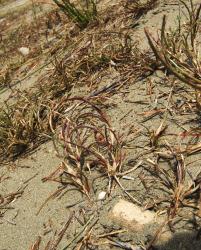- Taxon
- Gallery
- ≡ Aegilops incurva L., Sp. Pl. 1051 (1753)
- ≡ Lepturus incurvus (L.) Briq. (1910)
- = Aegilops incurvata L., Sp. Pl. 1490 (1763)
- ≡ Lepturus incurvatus (L.) Trin., Fund. Agrost. (Trinius) 123 (1820)
Small annual tufts to c. 35 cm. Leaf-sheath submembranous, glabrous, purplish, rounded, ribs ± inconspicuous. Ligule 0.3–1 mm, truncate, erose, projecting slightly upwards at either margin. Leaf-blade (1)–2.5–7.5 cm, flat, or incurved, c. 0.5 mm wide when dry, abaxially glabrous, adaxially with fine, hair-like prickle-teeth on ribs; margins and acute tip scabrid. Culm (1)–5–25 cm, loosely to densely tufted, sometimes solitary, usually much-branched below, prostrate, curved and ascending, or erect, few- to many-noded, internodes glabrous. Spikes (3)–7–10–(12) cm, curved or rarely straight, cylindric, rigid, green or purplish, rachis internodes ≤ spikelets, hollowed on one side, disarticulating horizontally below each spikelet at maturity. Spikelets 5–6.5 mm, embedded in cavities in rachis, solitary and alternating on opposite sides of rachis. Glumes ± equal and equalling spikelets, inserted side by side on rachis and appressed to it obscuring cavity, 4–5-nerved, rigid, much thickened, narrowly oblong-subulate, acute, hyaline margins minutely hairy. Lemma 3.5–4.5 mm, lanceolate, membranous, finely 3-nerved, lateral nerves short and very indistinct. Palea ≈ lemma. Lodicules c. 1 mm. Anthers 0.6–0.9 mm. Caryopsis 2.5–3 × 0.6–0.8 mm, enclosed between hardened glumes and segment of rachis. Fig. 7. Plate 4C.
[From: Edgar and Connor (2000) Flora of New Zealand. Volume 5 (second printing).]




